| THIS WEEK'S ARTICLES |
| The Mindful Investor |
| Magnificent 7 Stocks: Overheated or Just Getting Started? |
| by David Keller |
One of the key themes, if not THE theme, of 2023 was the dominance of the mega-cap growth trade. The Magnificent 7 stocks handily outperformed our equity benchmarks through the course of 2023, and, so far in 2024, it's been more of the same.
With Netflix (NFLX) gapping higher on earnings this week, the stock has certainly appeared to earn a place among the leading stocks of the day. But how do we handle names that have already had incredible runs and now appear overextended?
Today, we'll break down eight leading growth names, which I have loosely called "Magnificent 7 and Friends", and use the technical analysis toolkit to gauge the strength of trends and prospects for continued uptrends. We'll also see what an outlier Tesla (TSLA) has become after disappointing earnings and a price breakdown of epic portions.
The Best of the Best Continuing Higher
Over the last 12 months, the NYSE Fang Plus Index (NYSE+) has gained 76%, dwarfing the QQQ's +45% and SPY's +22%. While this index includes some other names outside the Magnificent 7, it remains a decent proxy for the strength of the mega-cap growth trade.
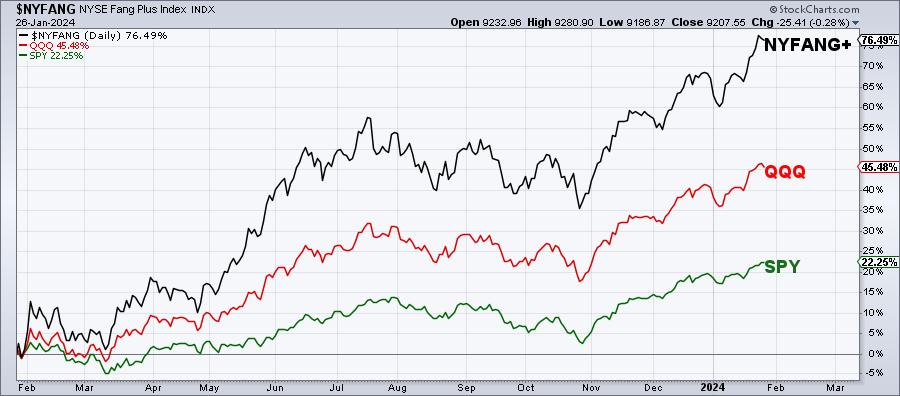
The first five charts in this group are similar in that they have broken out of clear basing patterns, and also have shown a clear pattern of higher highs and higher lows. Note how many of these names broke out above resistance, then pulled back to the previous resistance level before accelerating to a new swing high in January.
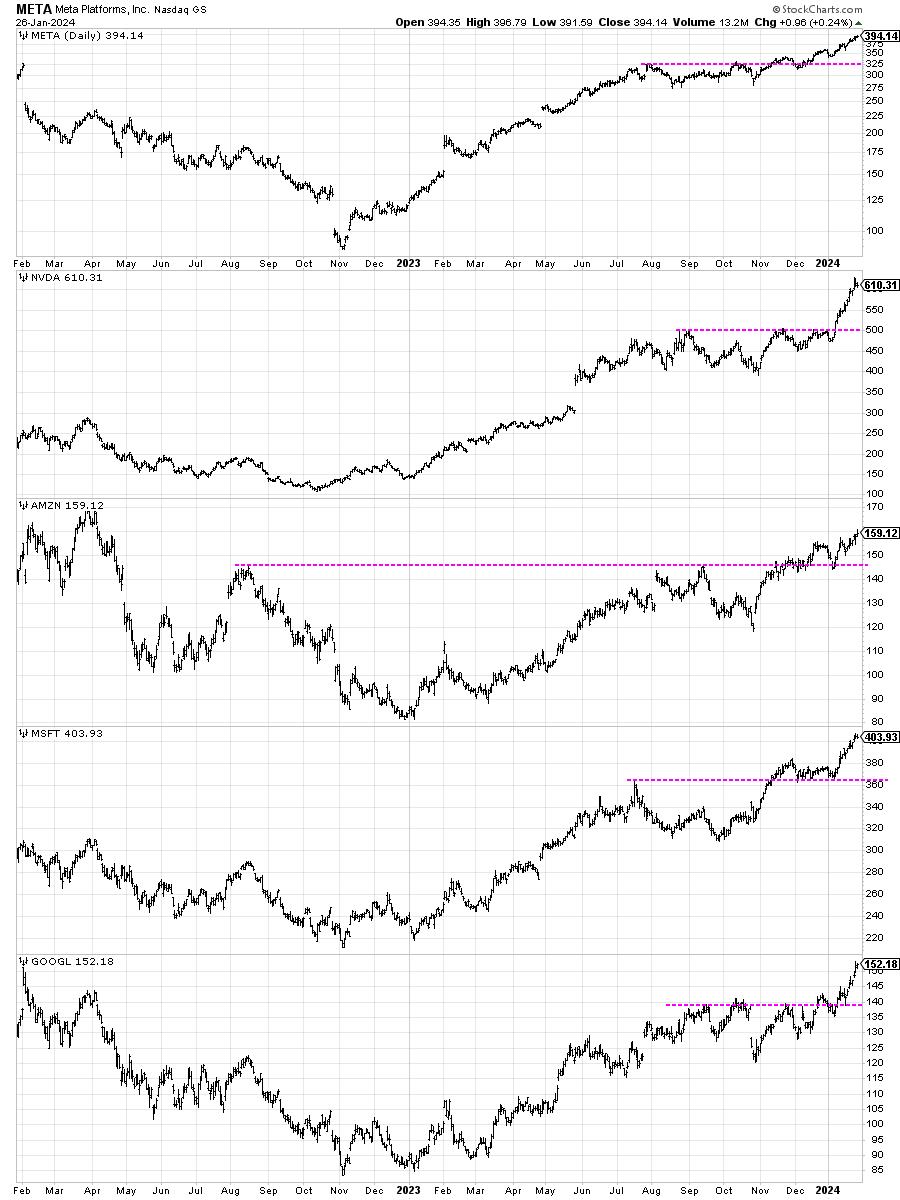
Strength tends to beget further strength, and Charles Dow clarified the importance of this concept by declaring that an uptrend consisted of a pattern of higher highs and higher lows. As long as these charts make a higher swing low on subsequent pullbacks, the primary trend remains bullish.
Netflix is a bit of an outlier, in that it was rangebound (similar to Apple, below) until gapping higher this week on earnings.
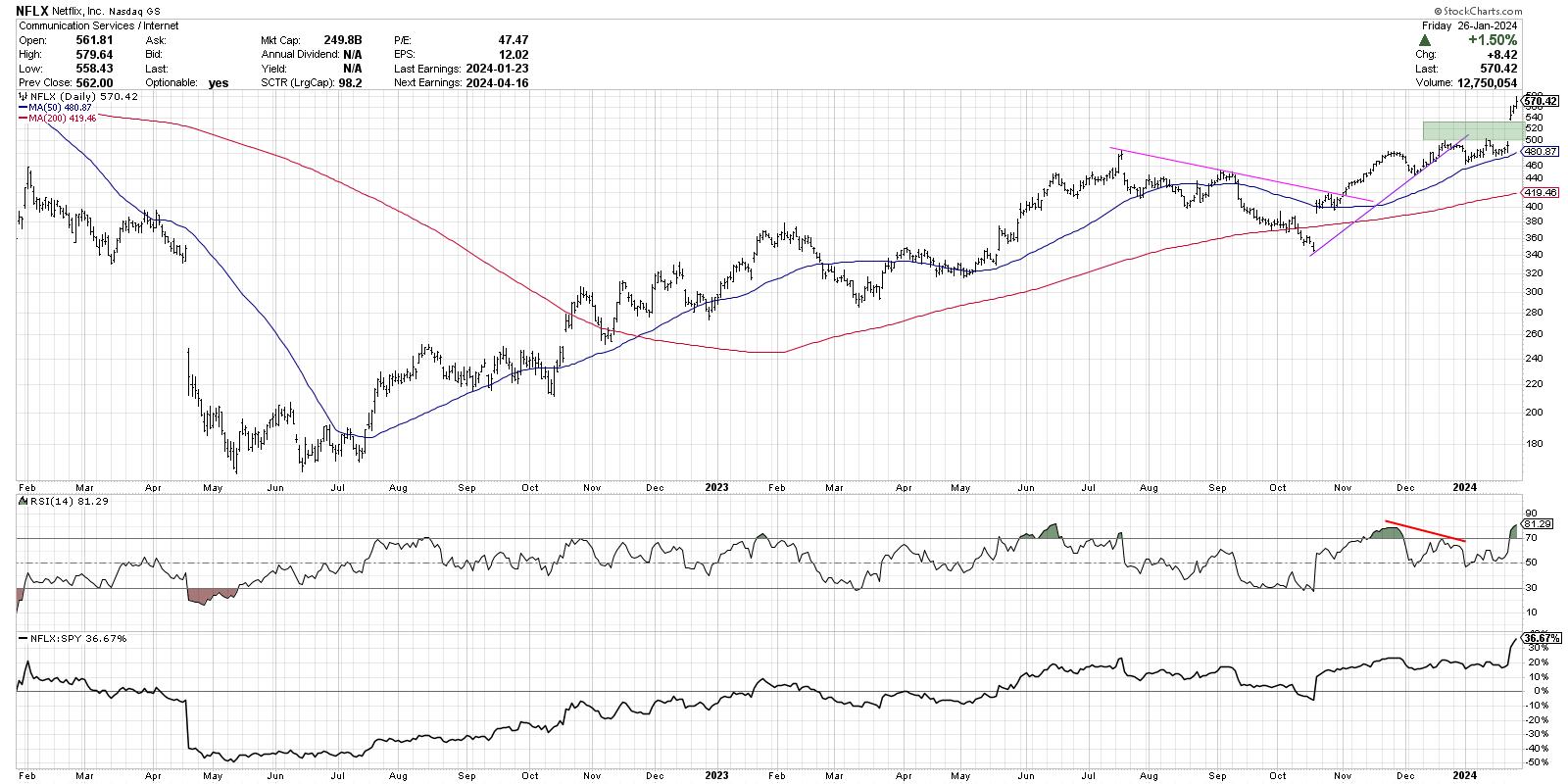
This week's upside gap pushed NFLX above key resistance around $500, and also created a new area of expected support between $500-530. As long as NFLX holds this range on a pullback, I'd consider the overarching sentiment to remain bullish.
One Name Still With Something to Prove
Here's where the charts will start to look a little different than the others we've shared thus far. While the first six names have already broken to new highs, Apple (AAPL) continues to languish below an well-established resistance level.
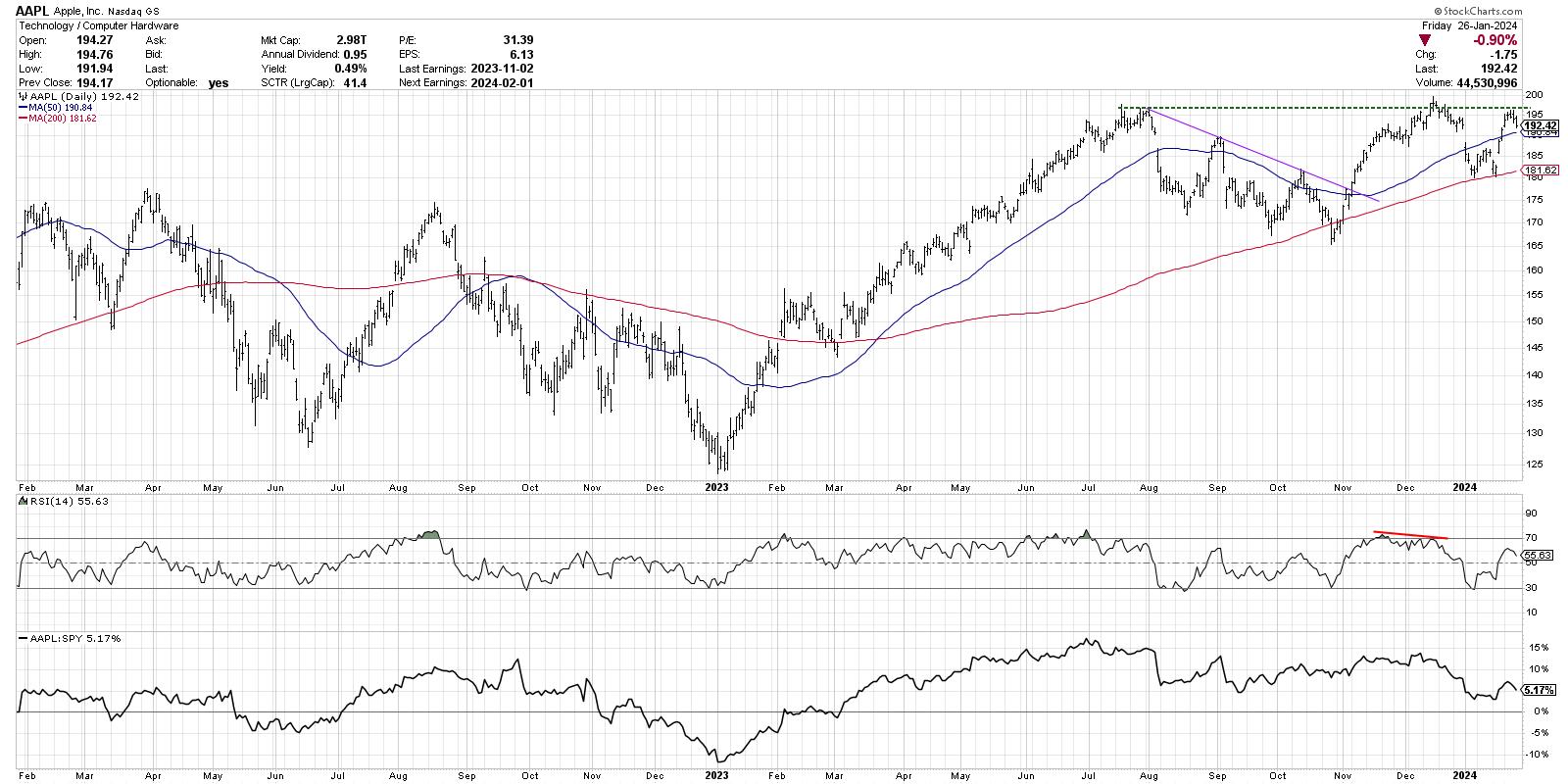
Apple hit a new 52-week high around $197 in July 2023. This level was briefly broken in December, but was unable to sustain those gains as the stock pushed lower to test its 200-day moving average. This week, AAPL once again tested the $197 level but couldn't power above this upside threshold. If and when AAPL gets above $197, and especially if it's able to power above the "big round number" of $200, I would consider this a bullish breakout in line with the previous charts we've presented here.
The Worst of the Worst Has Broken Down
And now we've reached the name which I would consider no longer worthy of membership in the elite Magnificent 7 club. After reviewing the chart below, and comparing it to all other charts we've shared, you'll see what an outlier Tesla has become.
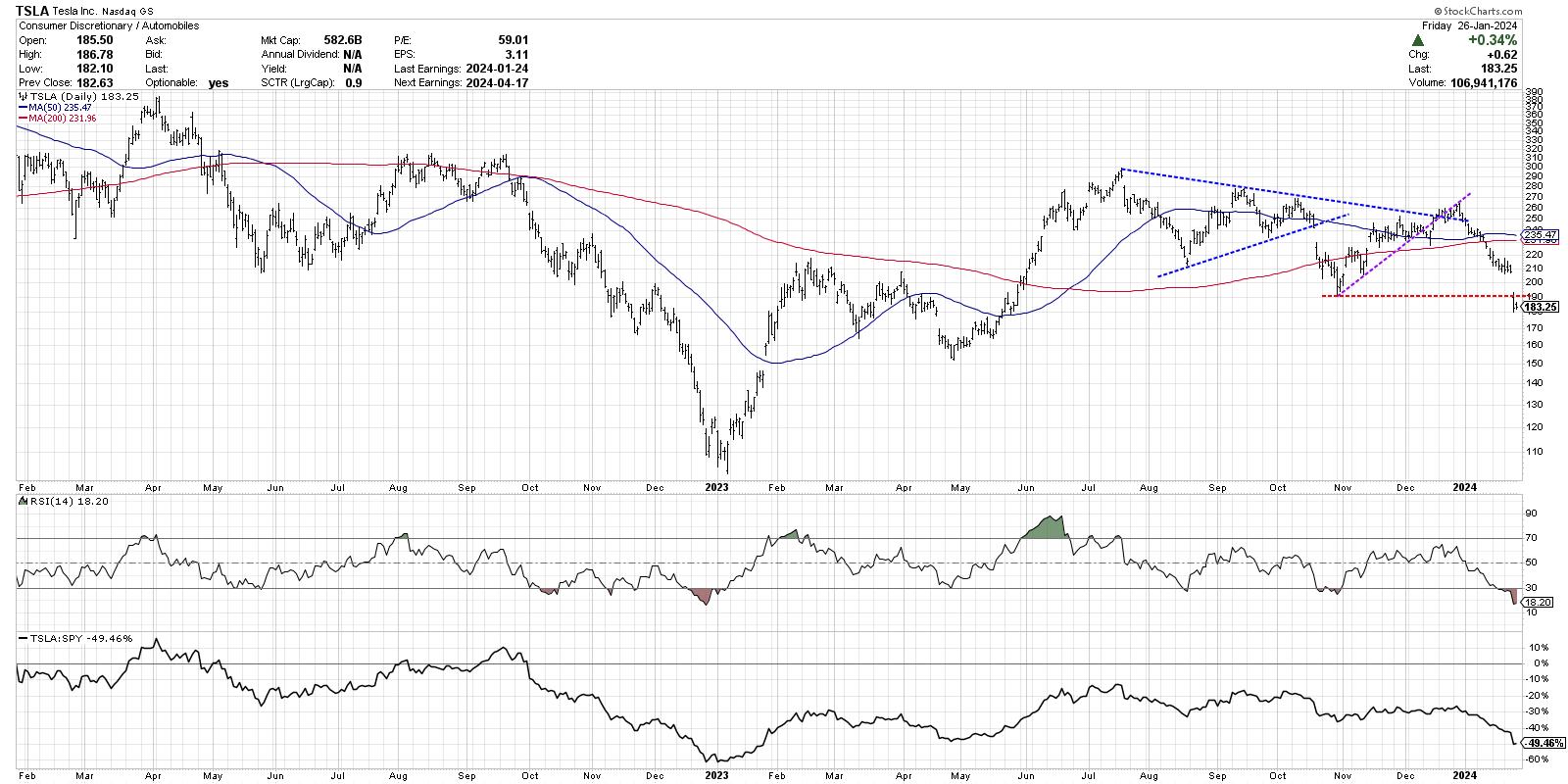
A first glance at the chart shows a similar structure to AAPL through summer 2023, as TSLA was able to reach the $300 market in July. From that point on, however, you'll notice a clear pattern of lower highs and lower lows. This is a Dow Theory downtrend, indicating a primary bearish trend and a general risk-off sentiment.
This week, TSLA gapped lower on an earnings miss, dropping the stock almost 14% for the week and pushing the price below the October 2023 low around $190. Unless TSLA is able to reclaim this level on a swing higher, and then establish a higher low, the primary trend remains down and I'd be very happy looking for better opportunities elsewhere!
Which of the Magnificent 7 (or 8?) stocks do you see as the best opportunity here, and why? By using a simple trend analysis of these names, it can be fairly easy to trim the outliers, focus on actionable moves, and better define potential reward vs. risk.
RR#6,
Dave
P.S. Ready to upgrade your investment process? Check out my free behavioral investing course!
David Keller, CMT
Chief Market Strategist
StockCharts.com
Disclaimer: This blog is for educational purposes only and should not be construed as financial advice. The ideas and strategies should never be used without first assessing your own personal and financial situation, or without consulting a financial professional.
The author does not have a position in mentioned securities at the time of publication. Any opinions expressed herein are solely those of the author and do not in any way represent the views or opinions of any other person or entity.
|
| READ ONLINE → |
|
|
|
| Martin Pring's Market Roundup |
| MEMBERS ONLY |
| What Does Dow Theory Say About This Market? |
| by Martin Pring |
|
Some tools in technical analysis are totally objective, such as a moving average crossover. It may be debatable whether it's a decisive signal or not, but a crossover is nevertheless a crossover...
|
| READ ONLINE → |
|
|
|
| Art's Charts |
| A Biotech Stock with a Breakout on the Weekly and a Classic Retracement on the Daily |
| by Arthur Hill |
 This week's analysis will stick with the multiple timeframe approach. Today we are featuring a biotech stock with a channel breakout on the weekly chart and a classic retracement on the daily chart. Moreover, a larger bullish reversal pattern could be forming on the daily chart. This week's analysis will stick with the multiple timeframe approach. Today we are featuring a biotech stock with a channel breakout on the weekly chart and a classic retracement on the daily chart. Moreover, a larger bullish reversal pattern could be forming on the daily chart.
The weekly chart below shows Biogen (BIIB) in a long-term downtrend, but showing early signs of a bullish reversal. Note that BIIB is part of the Healthcare SPDR (XLV) and the Biotech ETF (IBB), both of which are leading the market since late October. On the price chart, BIIB surged in September 2022 and broke resistance. The stock continued higher into July 2023 and then fell into October 2023. This decline formed a falling channel (blue trendlines) and returned to the breakout zone (green shading). Notice that BIIB held above the 2022 lows (green dashed line) and broke the upper line of this channel with the advance in late 2023. This is promising price action.
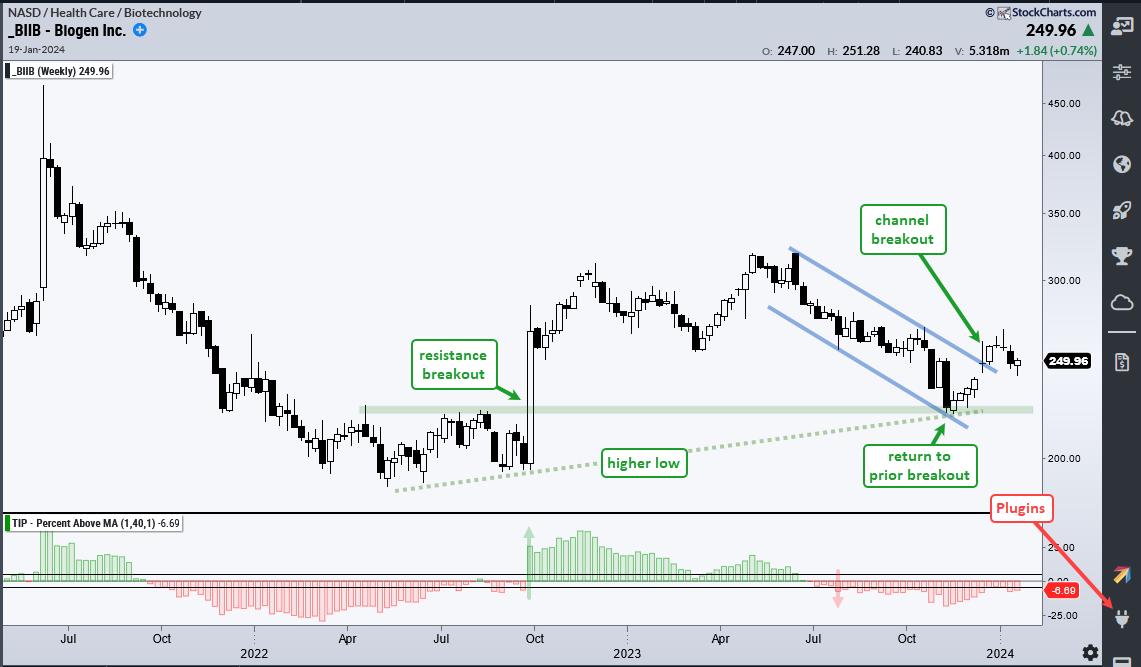
The indicator window shows the percentage difference between the close and the 40-week SMA. Note that this indicator is part of the TIP Indicator Edge Plugin for StockCharts ACP. There are signal thresholds at +5% and -5% to reduce whipsaws. An uptrend signaled with the breakout in September 2022 as the indicator exceeded +5% (green arrow). The uptrend remained until the indicator moved below -5% in July 2023 (red arrow). A move above +5% would turn it bullish again. Even though this trend-following indicator has yet to trigger, I am also seeing promising price action on the daily chart. The stock is trading in a potential reversal zone on the daily chart and a classic bullish reversal pattern could be taking shape.
This section continues at TrendInvestorPro Members (here). The Chart Trader offering at TrendInvestorPro provides broad market analysis and carefully curated trading setups for stocks and ETFs. We focus on bullish continuation patterns. Reports are published every Tuesday and Thursday before the open and each report includes a video. Click here to learn more.
//////////////////////////////////////////////////
|
| READ ONLINE → |
|
|
|
| ChartWatchers |
| Stock Market Indexes Keep Setting New Highs: How Much Higher? |
| by Jayanthi Gopalakrishnan |

In the first week of 2024, investors seemed uncertain that the stock market would continue the tail end of 2023 rally. But here we are, three weeks later, and the S&P 500 Index ($SPX) notches new record highs five trading sessions in a row. The last time this happened? November 2021.
It would have been nice to see the S&P 500 hit a record close to finish the trading week. It came so close.
Investors don't seem to be worried about anything right now. The CBOE Volatility Index ($VIX) remains relatively low at 13.29. This week, we received insight into some key economic data, which indicated, overall, that the US economy is slowing. This was good news for the stock market, which keeps going and going.
The Fed's most trusted inflation data point, the Personal-Consumption Expenditures (PCE) increased by 2.9%, below the 3.0% estimate. But consumer spending went up 0.7% in December, higher than expected. Consumers continued to shop, even though personal income was flat. Where's the money coming from?
Earlier in the week, the Q4 GDP was released, indicating the US economy grew at a 3.3% annual rate in the fourth quarter. It's higher than economists estimated, but it's also slower than Q3's growth, which was 4.9%.
So, overall, the data leading up to this week suggests that inflation has softened while the US economy is still strong. However, the growth is decelerating. Does that mean the US will see a soft landing? It's probably too early to tell, but it's something to listen for when Chairman Powell takes the podium next week after the Federal Reserve decision on interest rates.
The Fed is expected to hold interest rates steady in their next meeting, but investors will be listening for any clues hinting when rate cuts will start. According to the CME FedWatch Tool, there's about a 50% probability of the Fed cutting rates by 25 basis points in their March meeting.
Equities Still Rising
The stock market seems to be content with how the economy is performing. The S&P 500 ($SPX) and Dow Jones Industrial Average ($INDU) have been notching new highs this week. Technology stocks are back in favor, with many Tech and Communication Services reporting earnings next week. Intel's disappointing guidance may have dampened the enthusiasm in Tech, but overall, the sector has been rallying. The Invesco QQQ Trust (QQQ) has been rising since late October 2023 (see chart below).
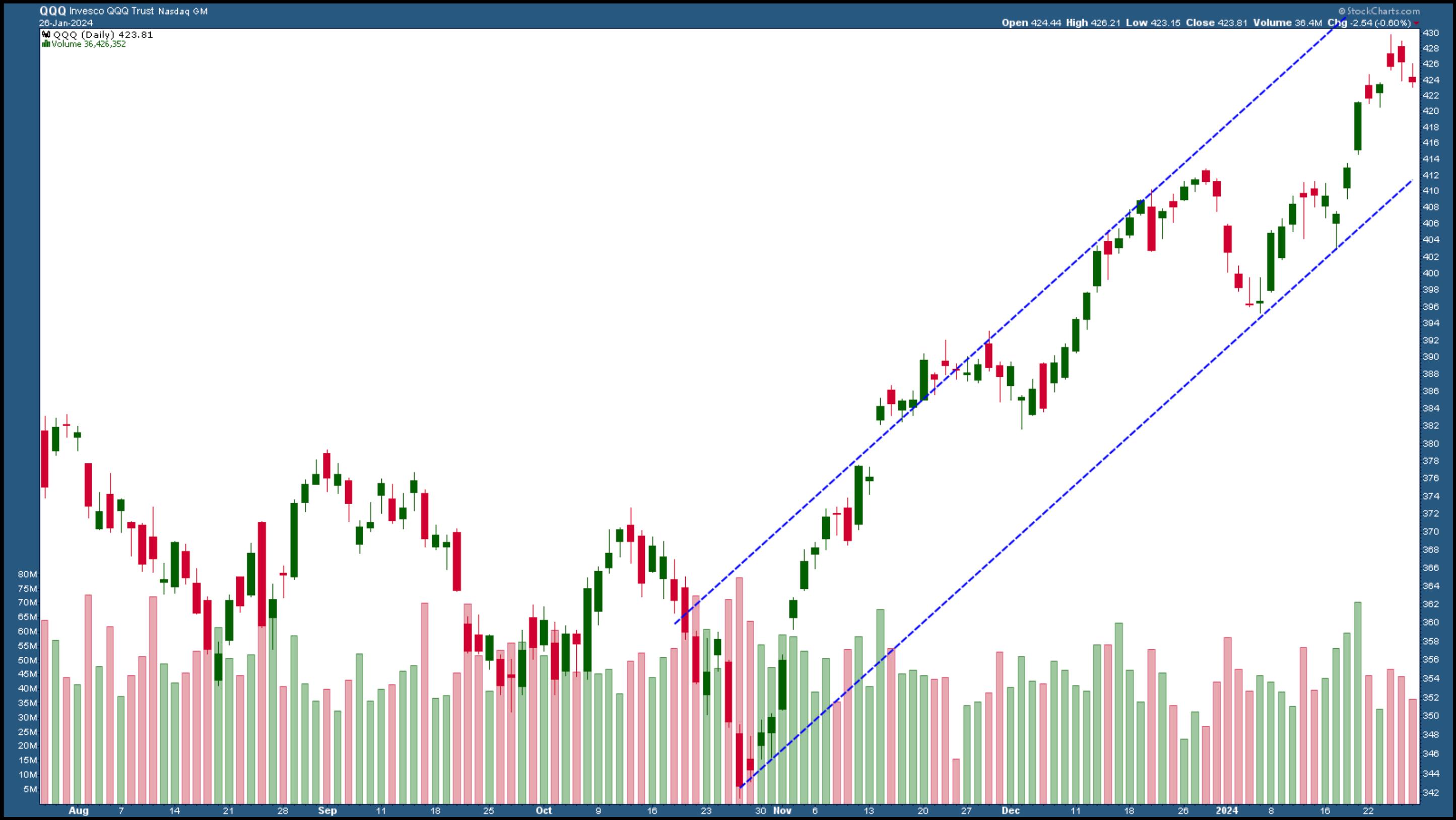
CHART 1. DAILY CHART OF QQQ. QQQ has been moving in an upward-sloping channel. A break above or below this channel can be an indication to which direction the QQQ will move.Chart source: StockCharts.com. For educational purposes.
Next week, some key tech players will be reporting earnings. Chip stocks are under pressure after Intel's and KLA Corp's weaker guidance. Investors will be closely listening to AMD's earnings next week. Will AMD provide guidance similar to Intel's? If it does, it will send a negative sentiment rippling through the sector. Watch the upward-sloping channel in the QQQ; a break above or below the channel will be an indication of which direction the QQQ will move.
This is why investors should always look at the broad picture when analyzing the stock market.
One useful indicator to follow is the Bullish Percent Index (BPI). It's helpful to have a ChartList of the BPI for the different sectors and major indexes. Looking through the BPI for the 11 S&P sectors, as of now, Consumer Staples, Utilities, and Energy are the only three sectors favoring the bears. But that could change.
Fed Week On the Radar
Interestingly, despite the rise in equities, the benchmark US 10-year Treasury yield ($TNX) has stabilized at around the 4.0–4.2% range. Is the bond market telling us something we may not know?
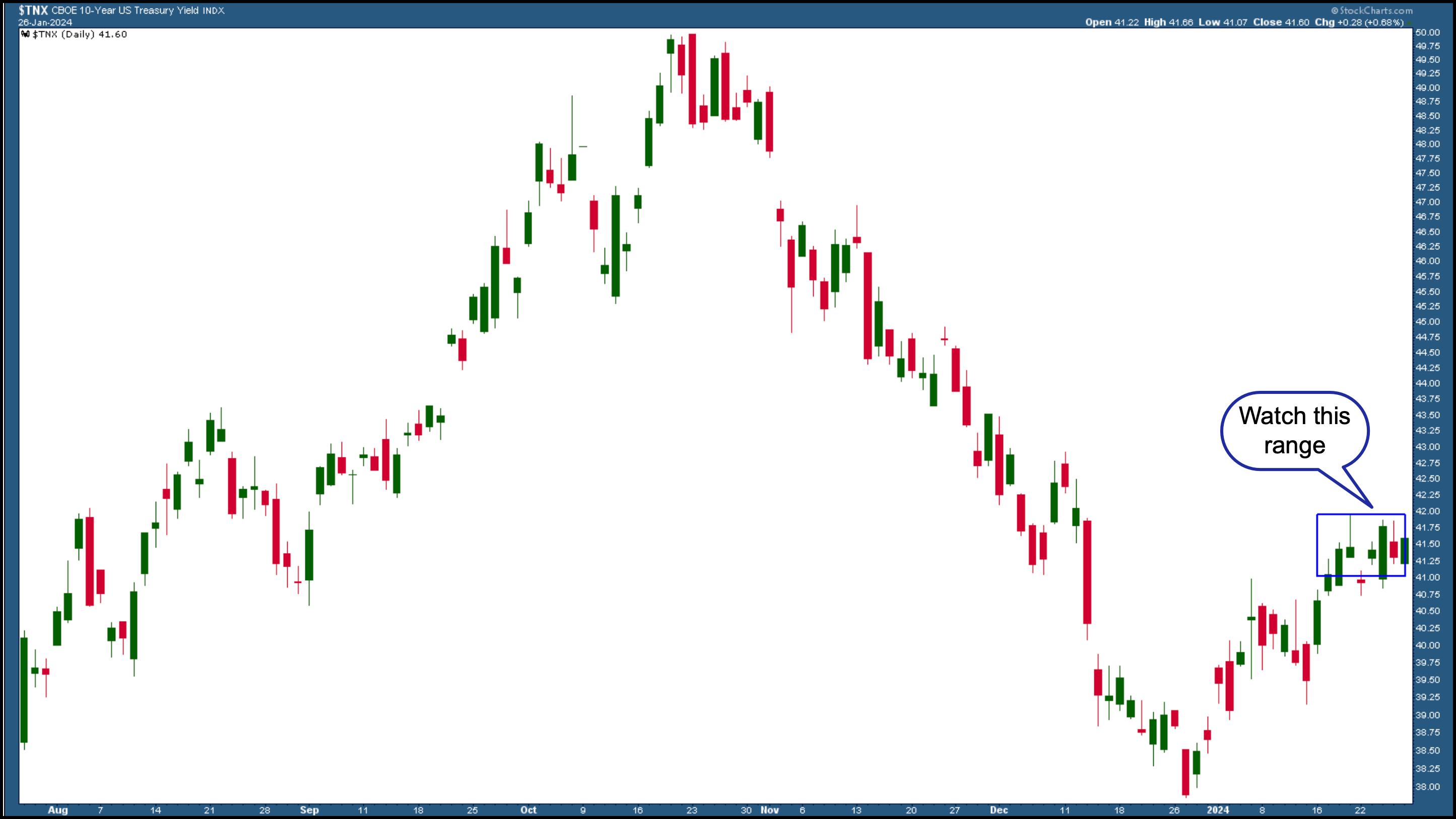
CHART 2. 10-YEAR US TREASURY YIELD STABILIZING. Watch the 10-year Treasury yields as we head into Fed week. They could be telling you something you may have missed.Chart source: StockCharts.com. For educational purposes.
Next week could bring some volatility, with several of the Magnificent Seven reporting next week and the FOMC meeting.
End-of-Week Wrap-Up

- S&P 500 down 0.07% at 38109.43, Dow Jones Industrial Average up 0.16% ; Nasdaq Composite down 0.36% at 15455.36
- $VIX down 1.41% at 13.26
- Best performing sector for the week: Energy
- Worst performing sector for the week: Consumer Discretionary
- Top 5 Large Cap SCTR stocks: Affirm Holdings (AFRM), Super Micro Computer, Inc. (SMCI); Veritiv Holdings, LLC (VRT); Nutanix Inc. (NTNX); CrowdStrike Holdings (CRWD)
On the Radar Next Week
- Earnings week continues, with Advanced Micro Devices (AMD), Alphabet Inc. (GOOGL), Microsoft Corp. (MSFT), Apple Inc. (AAPL), Amazon.com Inc. (AMZN), and Meta Platforms, Inc. (META) reporting.
- Federal Reserve Interest Rate decision
- Jan Non-Farm Payrolls (NFP)
- November S&P/Case-Shiller Home Prices
- Fed Interest Rate Decision
Disclaimer: This blog is for educational purposes only and should not be construed as financial advice. The ideas and strategies should never be used without first assessing your own personal and financial situation, or without consulting a financial professional.
|
| READ ONLINE → |
|
|
|
| Trading Places with Tom Bowley |
| Value Stocks' Continued Strength Might Depend on One Area Of Transports |
| by Tom Bowley |
I know all the talk continues to surround technology stocks (XLK), particularly semiconductors ($DJUSSC) and software ($DJUSSW). And why wouldn't it? These groups have been absolutely on fire since the end of the 2022 cyclical bear market. Rates remain low and many of these companies are seeing double digit profit growth. As I've said often, this is NIRVANA for growth stocks. But there comes a time, if we use perspective, that these stocks simply get ahead of themselves in terms of valuations. I don't believe that these areas will simply fall apart as conditions remain conducive for further growth. The economy remains resilient (think soft landing), however, and other areas are showing improvement and strong EPS growth. Bull markets are known for periodic rotation to keep things humming along, so ruling out value areas would be a mistake in my mind.
Financials
Many banks ($DJUSBK) are posting EPS ahead of expectations and the group looks better technically than it has in more than 2 years. As an example, let's check out the weekly chart of regional banks (KRE):
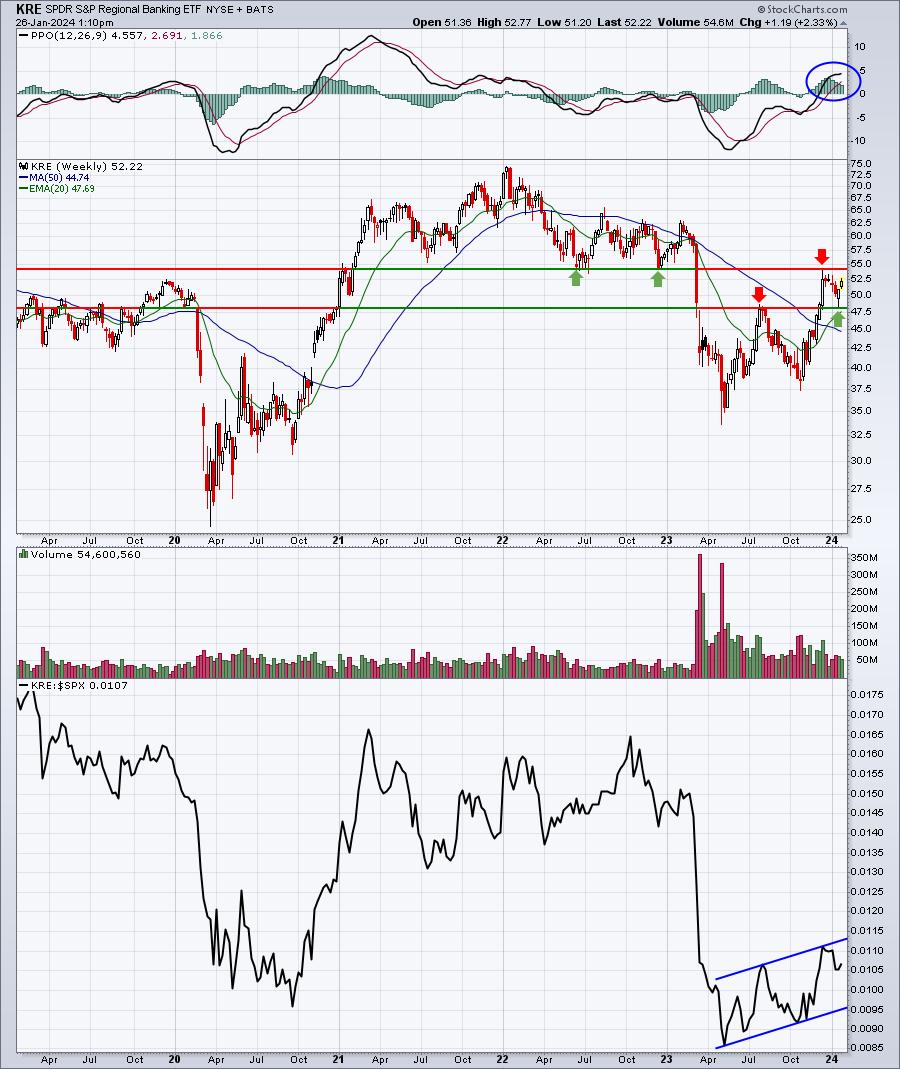
The weekly PPO has turned higher and bullish momentum appears to be accelerating. After significant deterioration in relative strength in March and April, we've seen the KRE trend higher in terms of its relative performance vs. the benchmark S&P 500.
As the Fed lowers the fed funds rate in 2024, we'll see a reversing of the inverted yield curve. No area of the market is hit harder by an inverted yield curve than banks. The reversal will provide tailwinds for the group and I believe those tailwinds are already being felt.
On Monday, I'm featuring a financial stock that reported EPS well above its consensus estimate and appears poised for much further price appreciation in 2024. It pays a very nice dividend, so it's likely to be a stock that satisfies investors looking for both capital appreciation AND income. To register for our FREE EB Digest newsletter, simply CLICK HERE to provide your name and email address. There's no credit card required and you can unsubscribe at any time.
Industrials
While financials, and particularly banks, have shown steady improvement in the second half of 2023 and into 2024, many areas of industrials continue to struggle. One key area will be transportation stocks ($TRAN). The TRAN just hit significant long-term relative support as you can see here:
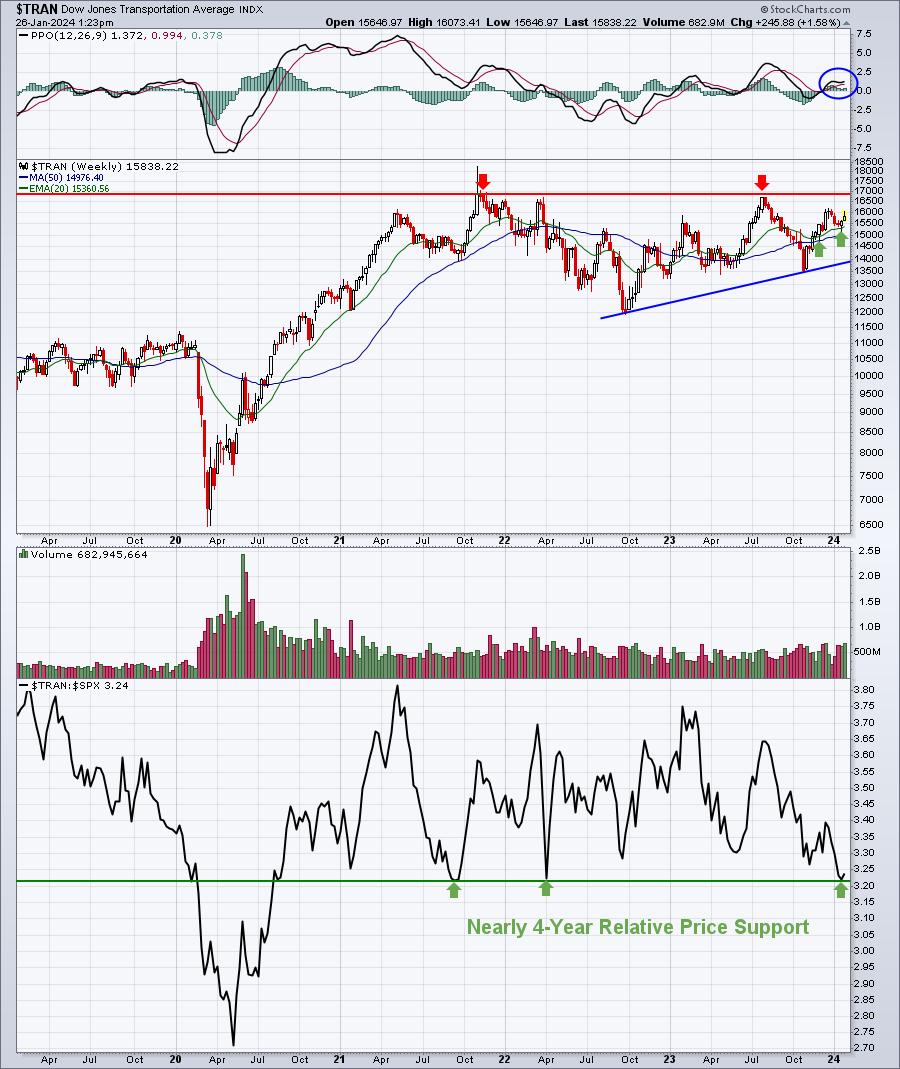
That relative strength line just hit major relative support and is beginning to turn higher. If it's going to keep pushing higher, then a critical area to watch is railroads ($DJUSRR). I think they could hold the key for all of transportation in 2024. The chart below shows that railroads were strengthening in Q4, but weakened on a relative basis as the group consolidated in a potential cup with handle pattern. Should this break to the upside, I see the DJUSRR providing renewed leadership and allowing transportation to push much higher in 2024. Check out railroads:

Railroads are testing the lower channel line in its relative uptrend channel (red circle). It's typical for stocks or industry groups to lose relative strength while they consolidate in an uptrending market. The cause is rotation as traders await another breakout to return to the group. Should railroads breakout above 3425 or so, I'd look for it to be the catalyst to further strength in transports. Ultimately, this would lead to relative strength in the industrials sector.
Happy trading!
Tom
|
| READ ONLINE → |
|
|
|
| Don't Ignore This Chart! |
| IBM Stock Shatters Expectations, Hitting a New All-Time High: A Buying Opportunity? |
| by Karl Montevirgen |

As a trailblazer in the tech industry, IBM stands out as an "OG'' among corporate tech giants. Yet the company is far from turning into a relic. It continues to make significant progress distinct from its more progressive rivals.
IBM may not be the hippest among the tech bunch nor the most progressive (certainly not an AI play). Yet its strategy—focusing on providing software and services to corporate clients—has paid off, which makes it an attractive tech stock. Last week, IBM hit a new all-time high after reporting stellar earnings this past week. The stock broke above a rising multi-year trend channel (on a weekly chart scale) and spiked well above its upper Bollinger Band® on the daily chart.
Let's look at the five-year weekly chart of IBM's stock price (see chart below).

CHART 1. WEEKLY CHART OF IBM STOCK. The stock traded within a wide trending channel for four years before breaking out.Chart source: StockCharts.com. For educational purposes.
On the left side of the screen, you'll see that prices were already rising within a narrow channel prior to plunging during the COVID Crash of 2020. As IBM recovered, it began trending upward again, but this time within a much wider channel, roughly twice the size of the previous (2019) one. Within these five years, IBM has been trading upward, but at a volatile and slow pace.
But then things started to change in the latter part of 2023. IBM's stock price moved above the longer-trend channel and into the ultra-bullish and parabolic move, culminating in this week's 13% spike. Note, however, that the longer-term divergence between prices and buying pressure as measured by the Chaikin Money Flow (lower panel).
As in most cases, bullish momentum on parabolic moves such as this one can't be sustained, but the overall uptrend can, given a significant "breather" or pullback. So, if you're considering entering a position in IBM, it's worth exploring where this pullback might lead the stock.
Let's take a look at the daily chart.

CHART 2. DAILY CHART OF IBM. The stock price goes parabolic, but the CMF is declining, and there's a price rejection from IBM's all-time high.Chart source: StockCharts.com. For educational purposes.
After a three-month basing period from February to May last year, IBM resumed its uptrend, pulling back again in September, only to shift gears on a bullish breakaway gap at the end of October.

- IBM closed above the upper Bollinger Band on January 12 and kept riding that line until January 24, when it was slated to report earnings after the close.
- The stock gapped up to open on January 25 following a stellar earnings report.
- Though IBM closed higher and above the upper band, note the significant price rejection from the high of 196.9.
- In addition to the RSI placing IBM's price in overbought territory, note the decline in buying pressure measured by the CMF; both suggest that a pullback is more or less imminent.
So, when might be a favorable time to start loading up on IBM shares? It might be tempting to think it's too late to invest when a stock reaches a new peak. However, it's important to remember that stocks' value fluctuates, especially when the surge is this steep. So, it's best to exercise patience and wait for a pullback, as those pullbacks present favorable entry opportunities.
Bottom Line: Keep Your FOMO in Check
Checking out IBM's stock chart, you'll notice moments in its uptrend where the price dipped back to the middle Bollinger band before bouncing back up. Also, price fluctuations occur within the Bollinger band 95% of the time, suggesting that IBM's current high is a 5% outlier and bound to fall back toward the middle band. This will likely happen; you might want to give it a few days.
Also, you might want to set a price alert at around $182.50, which is the middle of IBM's runaway gap. Gaps tend to get filled. While that level may still be too high a price level to go long, setting an alert will at least tell you when to begin closely monitoring the stock. You could wait for IBM's stock price to fall toward the middle band and wit for a bounce with strong momentum before entering a long position.
How To Set a Technical Price Alert
Setting a technical alert at these support and resistance levels would be helpful as you weigh your potential entry points against any market developments that may influence your decision.
To access the Technical Alert Workbench, follow these steps:
- Log in to your StockCharts account.
- At the top of any page, click on Your Dashboard.
- Click the Alerts or the New button in the Your Alerts panel.
- Choose which type of alert you want to create from the Alert Type buttons at the top left. To create a price alert, select Price Alert as the alert type.
- Add IBM in the symbol box and set your price trigger.
- Choose how you wish to be notified and click the Save Alert button.
Disclaimer: This blog is for educational purposes only and should not be construed as financial advice. The ideas and strategies should never be used without first assessing your own personal and financial situation, or without consulting a financial professional.
|
| READ ONLINE → |
|
|
|
| Top Advisors Corner |
| D.R. Horton's Earnings Spells Trouble for the Homebuilder Stocks |
| by Joe Duarte |
Those of us who have been bullish on the homebuilder sector got a reality check on 1/23/24 when, despite beating on revenues, D.R. Horton (DHI) missed earnings expectations and the stock tanked, taking prices for other homebuilders such as Lennar (LEN) down as well.
Despite the overall positive tone of the report, especially the company's continuing ability to make money, inside there were several reasons to be concerned. In particular, there was the order backlog of homes under contract, which shrunk by 11%, while it looks as if unsold inventory is starting to climb, with 730 completed homes sitting on lots for over six months without being sold. That suggests that Horton may be building fewer houses and that the ones that are ready to go are taking longer to sell.
But here's what most concerning: the report covered earnings which corresponded to the period extending from October 1 to December 31, 2023. That's when the U.S. Ten Year Note yield (TNX) and mortgage rates topped out, as I predicted they would, at 5%, before falling to 3.8%. What we heard from companies reporting and commenting during that period was the drop in mortgage rates was bringing in buyers from the sidelines. We also heard that the incentives offered by builders, such as buying down points to reduce mortgage rates as well as lowering prices and adding amenities to homes at low prices, were also increasing sales.
At the same time, the latest figures for new home sales (December 2023) beat expectations both month over month and year over year, while existing home sales cratered to new lows. So, if things were turning around, then why is Horton's order backlog falling, and why does it have a bunch of houses sitting on the unsold lot for greater than six months?
I spoke to a realtor friend who may have the answer. She told me that she had taken some clients to a DHI property during that period and that they were turned down for a DHI-backed mortgage. She took them elsewhere and they got a loan.
All of which raises the question of whether Horton was managing its risks by enforcing very tight lending standards, or whether the credit worthiness of potential homebuyers has now deteriorated to the point where lower mortgage rates, incentives, and rain dances are not going to help people buy homes.
In other words, while demand remains strong and supplies remain tight, the personal finances of would-be buyers may not be good enough for lenders to take risks.
Has the Fed Killed the Economy?
Central to the argument now is the question of whether the Federal Reserve's rate hikes and the consequential rise in bond yields have reached the point where homebuilders are becoming concerned about the credit quality of potential buyers, and thus their inventory is quietly increasing as their sales slow. Moreover, if this is true, then the longer the Fed keeps rates at current rates and bond yields continue to rise, it's worth asking: Is the recession that hasn't come to fruition yet about to become apparent?
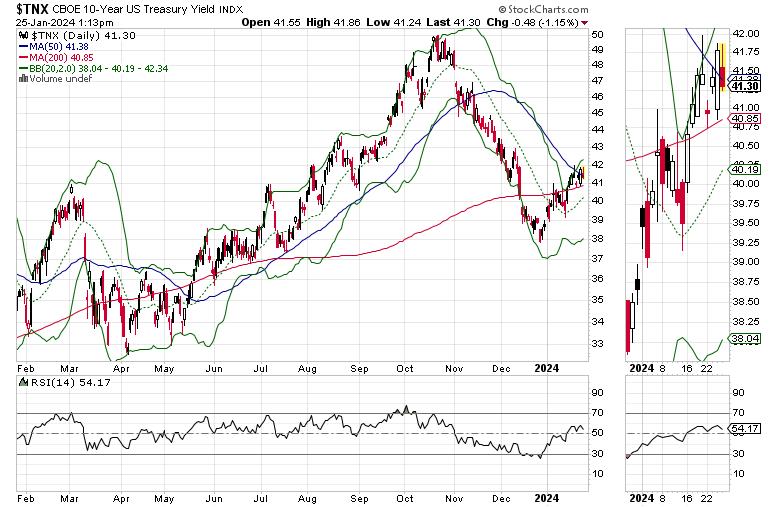
The U.S. Ten Year Note yield (TNX) has now crossed above the important 4.1%-yield area and its 200-day moving averages, which are both negative developments. It is also testing the important 50-day moving average resistance area. If this persists, bond yields will likely continue to rise until the Fed finally lowers rates or inflation shows signs that it's cooling off over the long term.

The rise in yields brought added to the problems caused in the shares of D.R. Horton by its earnings report. The shares are now testing the support of the 50-day moving average. Both Accumulation/Distribution (ADI) and On Balance Volume (OBV) tumbled as short-sellers seized on the opportunity (ADI) and buyers became sellers (OBV). We'll see if the shares can hold up at these levels. The next support level is at 130.
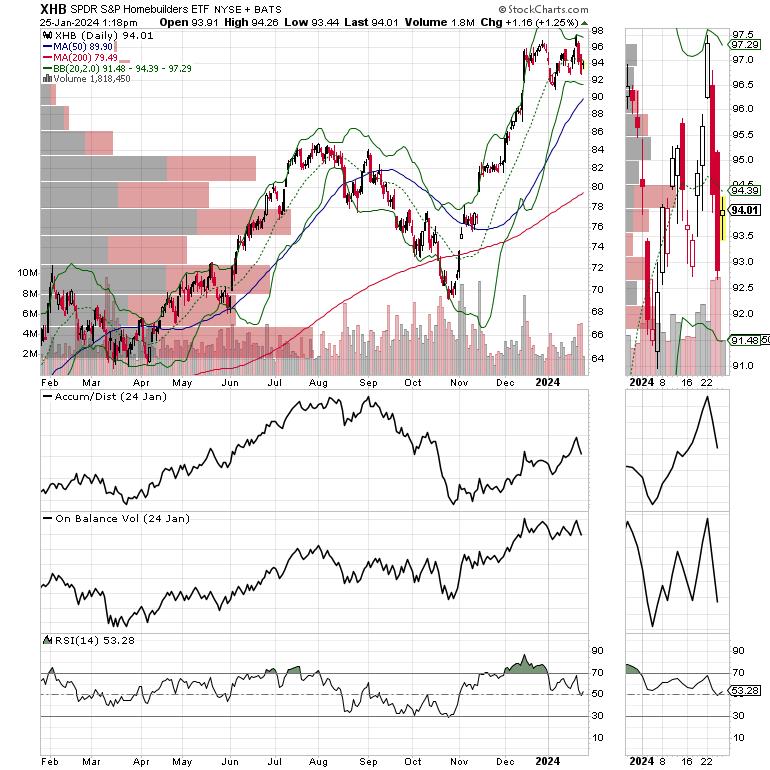
Overall, the homebuilder sector, as in the SPDR S&P Homebuilder ETF (XHB), held up better than DHI. But ADI and OBV for this ETF are also cautionary. A break below $90 for XHB would be very concerning.
Bottom Line
The earnings miss by D.R. Horton raises red flags, and suggests that the damage to the housing market caused by the Fed's rate increases may go a bit deeper than previously thought.
It is possible that, even though supply and demand continue to favor the homebuilders, the business itself is starting to plateau. In essence, the housing market may be faced with a new problem; consumers whose personal financial situation is deteriorating may not qualify for purchases in the current environment. This situation is likely to worsen if layoffs increase over the next few months, as the technology and related sectors continue to downsize their workforces.
If this is how the situation unfolds, then the Fed and the economy may be in worse trouble than most investors realize.
DHI is the bellwether. Because although the company's profit prospects are well above average, it looks as if growth is about to slow, and perhaps maybe even stall, if interest rates don't ease.
Thanks to everyone for your support. I really appreciate it. This weekly report is available on my Buy Me a Coffee Page. If you like this report and want to receive early access this type of content on a regular basis, consider becoming a member. I also appreciate single coffees, which you can buy me here.
To subscribe to my premium service, Joe Duarte in the Money Options.com, click here. Please don't forget to hit the Like button on the posts. It helps to spread the word.
You're the music. I'm just the band.
To get the latest information on options trading, check out Options Trading for Dummies, now in its 4th Edition—Get Your Copy Now! Now also available in Audible audiobook format!
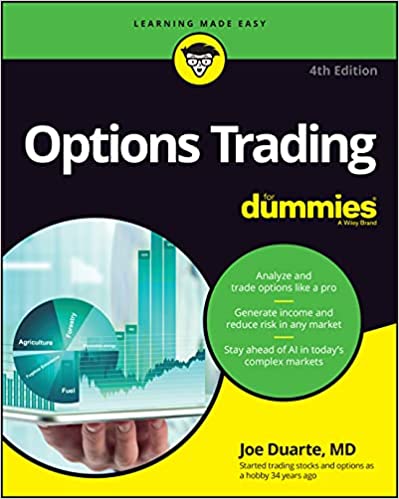 #1 New Release on Options Trading! #1 New Release on Options Trading!
Joe Duarte
In The Money Options
Joe Duarte is a former money manager, an active trader, and a widely recognized independent stock market analyst since 1987. He is author of eight investment books, including the best-selling Trading Options for Dummies, rated a TOP Options Book for 2018 by Benzinga.com and now in its third edition, plus The Everything Investing in Your 20s and 30s Book and six other trading books.
The Everything Investing in Your 20s and 30s Book is available at Amazon and Barnes and Noble. It has also been recommended as a Washington Post Color of Money Book of the Month.
To receive Joe's exclusive stock, option and ETF recommendations, in your mailbox every week visit https://joeduarteinthemoneyoptions.com/secure/order_email.asp.
|
| READ ONLINE → |
|
|
|
| MORE ARTICLES → |
|






 This week's analysis will stick with the multiple timeframe approach. Today we are featuring a biotech stock with a channel breakout on the weekly chart and a classic retracement on the daily chart. Moreover, a larger bullish reversal pattern could be forming on the daily chart.
This week's analysis will stick with the multiple timeframe approach. Today we are featuring a biotech stock with a channel breakout on the weekly chart and a classic retracement on the daily chart. Moreover, a larger bullish reversal pattern could be forming on the daily chart.
























